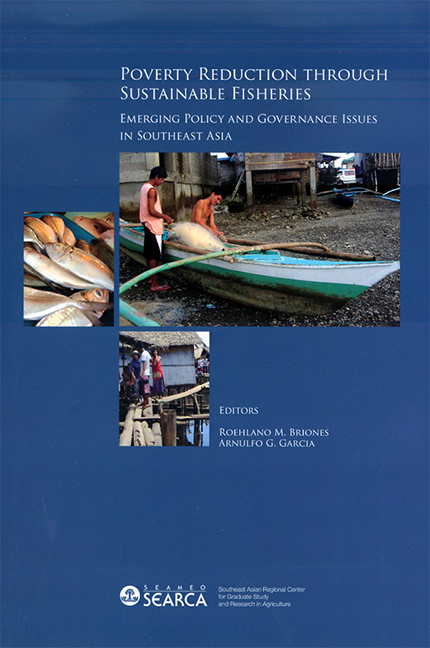 Poverty Reduction through Sustainable Fisheries
Poverty Reduction through Sustainable Fisheries Book contents
- Frontmatter
- Contents
- Figures
- Tables
- Foreword
- Acknowledgments
- 1 Introduction and Synthesis
- 2 Fish and the Poor
- 3 Fish and the Poor: The Case of Cambodia
- 4 Changing Demand and Supply Structure of Fish in Asia: Past Trends and Future Projections
- 5 Regional Economic Integration of the Fisheries Sector in ASEAN Countries
- 6 Technology Policies for Capture Fisheries and Aquaculture in Southeast Asia
- 7 The Status, Current Trends and Future Directions for Production and Technology of Fisheries in Southeast Asia
- 8 The Seafood Supply Chain and Poverty Reduction
- 9 Strategy for the Empowerment of Aquaculture Fish Farmers in Indonesia
- 10 Status of Coastal and Marine Resources: Implications for Fisheries Management and Poverty in Southeast Asia
- 11 Property Rights and Institutional Arrangements in Southeast Asian Fisheries
- 12 Regional Cooperation in Aquatic Resource Management for Southeast Asia
8 - The Seafood Supply Chain and Poverty Reduction
Published online by Cambridge University Press: 21 October 2015
- Frontmatter
- Contents
- Figures
- Tables
- Foreword
- Acknowledgments
- 1 Introduction and Synthesis
- 2 Fish and the Poor
- 3 Fish and the Poor: The Case of Cambodia
- 4 Changing Demand and Supply Structure of Fish in Asia: Past Trends and Future Projections
- 5 Regional Economic Integration of the Fisheries Sector in ASEAN Countries
- 6 Technology Policies for Capture Fisheries and Aquaculture in Southeast Asia
- 7 The Status, Current Trends and Future Directions for Production and Technology of Fisheries in Southeast Asia
- 8 The Seafood Supply Chain and Poverty Reduction
- 9 Strategy for the Empowerment of Aquaculture Fish Farmers in Indonesia
- 10 Status of Coastal and Marine Resources: Implications for Fisheries Management and Poverty in Southeast Asia
- 11 Property Rights and Institutional Arrangements in Southeast Asian Fisheries
- 12 Regional Cooperation in Aquatic Resource Management for Southeast Asia
Summary
ABSTRACT
In this paper, we review, compare and contrast the characteristics of seafood supply chains in developed and developing countries, using the value chain governance approach. It is identified that the linkage between poverty reduction and development of seafood industry in developing countries is contingent on the nature of chain governance. Based on the comparative and contrastive results, recommendations for enhancing the functionality of poverty alleviation for seafood supply chain in developing countries are proposed.
INTRODUCTION
The fishery sector contributes significantly to many coastal economies in generating income, employment, and foreign exchange earnings. In addition, the fishery sector is one of the key contributors to food security and poverty alleviation in many developing nations. It is deemed as being highly significant in most Southeast Asian countries, both in trade and consumption, and employment and poverty terms (Thorpe, 2005). Global fishery production increased, at an annual rate of 1.7 per cent, from 130 mmt (million metric tons) in 2000 to 140 mmt in 2004. While developed nations registered a slight decline of 1.5 per cent during the 2000-2004 period, they managed to increase their production at an annual rate of 2.7 per cent, raising its share from 75.5 per cent in 2000 to 78.5 per cent in 2004. During the same period, the ten Southeast Asian nations showed an even more impressive growth at an annual rate of 5.7 per cent reaching almost 22 mmt in 2004 (FAO FishStat 2006).
Much of the increase in fishery production can be attributed to trade liberalisation and globalisation, resulting in a significant increase in global fish trade. Global fish export increased from $55.6 billion in 2000 to $71.7 billion in 2004, at an annual rate of 6.6 per cent. The relative importance of fish trade can be seen in its export share of total merchandise exports and agricultural exports. In 2004, fish export share to total merchandise export was less than 1 per cent globally, but fish export share of the developing countries was almost twice as much as that of the developed countries at 1.1 per cent.
- Type
- Chapter
- Information
- Poverty Reduction through Sustainable FisheriesEmerging Policy and Governance Issues in Southeast Asia, pp. 145 - 188Publisher: ISEAS–Yusof Ishak InstitutePrint publication year: 2008


